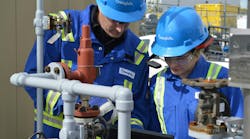| Project Parameters: >> Inlet gas temperature: 1,338 F (726 C) >> Duct size: 106-inch diameter (269 cm) >> Abrasion-resistant materials of construction >> Service life: Five years. Equipment use variable – used only when boiler is unavailable Desired exit gas temperature: 600 F (316 C) >> Operating pressure (liquid): 80 PSIG to 100 PSIG >> Operating pressure (steam): 80 PSIG >> Flowrate: 300+ GPM (1136+ l/min) >> Spray fluid: Condensate at 200 F (93 C) >> 100 percent evaporation to eliminate corrosion and build-up problems >> Preferred use of steam instead of compressed air as it was readily available |
Refinery compliance with EPA MACT II standards is not a new topic. But the need for compliance has led to new technology and new solutions as deadline-driven upgrade and expansion projects progress rapidly.
Like many refineries, the Houston-based facility under consideration here uses Waste Heat Steam Generators (WHSG) to burn off excess carbon monoxide (CO) from gas before the hot gas flows downstream to other refinery processes. In the event of boiler failure or maintenance, the gas still needs to go through selective catalytic reduction (SCR) for nitrogen oxide (NOx) control prior to being released into the atmosphere.
Working in conjunction with an engineering firm, it was determined that a new bypass duct was required to divert the gas downstream to a new wet scrubber system. However, the temperature of the gas needed to be lowered prior to entering the wet gas scrubber. If the gas was too hot, particulate removal would be compromised and significant damage to the SCR was likely.
The engineering firm contacted Spraying Systems Co. (www.spray.com) for assistance with induct gas cooling. Project parameters were provided, and Spraying Systems was asked to recommend a solution.
The solution, proposed after completion of a series of cooling calculations, involved installing eight spray injectors, each with two high-efficiency gas atomizing nozzles. The placement of two nozzles at compound angles on each injector allowed high flowrates to be achieved while maintaining small drop size and fast evaporation. Using two nozzles per injector also required fewer taps into the process duct.
The next consideration was injector placement. To accommodate an existing catwalk, the injectors needed to be placed around half of the duct in a semi-circle. The inner duct diameter of 106 inches dictated that the injectors could only extend 4-6 inches into the gas stream. The exact placement was determined after analyzing how droplets would heat up and change phase once in the process stream. Once that was established, the injectors were positioned to avoid wetting of refractory lining.
Then it was time to select the type of gas atomizing nozzles best suited for the application. Given the objective of 100 percent evaporation to eliminate downstream wetting, the decision was made to use Spraying System Co.’s FloMax gas atomizing nozzles. FloMax nozzles use patented atomization techniques to produce very small drops that are quickly evaporated.
FloMax nozzles also offer a unique benefit ideally suited to this application, as they can be used with steam without significant performance changes.
Reaction-bonded silicon carbide and 316 stainless steel were recommended as materials of construction to provide the necessary level of abrasion resistance and long-term application service requirements.
The engineering firm and refinery personnel accepted the proposal from Spraying Systems and authorized the manufacture of a mock-up injector for fit use during the WHSG upgrade.
The production injectors were fabricated in accordance with ASME B31.3 Process Piping Code. All materials underwent Positive Material Identification (PMI) in addition to obtaining Material Test Reports (MTR) from every material manufacturer. Every injector underwent extensive non-destructive examination prior to delivery as an additional safety measure.
The injectors were installed upon delivery and put into use immediately while boiler renovation continued. The injectors efficiently cooled gas to 600 F with 100 percent evaporation for several months. During initial startup of the boiler while the refractory was still curing, the injectors were pushed to a combined flow of 400 GPM – 30 percent beyond the design conditions. Evaporation remained at 100 percent, and the injectors successfully handled the increased volume. The boiler has now been returned to service and the bypass duct and injectors will only be used during emergencies or the next maintenance shutdown in 2012.
The design, fabrication and testing of the injectors took just three months, keeping pace with the refinery’s voluntary emission reduction program and construction deadlines. The injectors provided a cost-effective solution for the refinery since the existing steam, ductwork and catwalk could be used.
Daniel Vidusek holds a bachelor’s degree in mechanical engineering from Southern Illinois University and has more than 20 years of spray nozzle design experience, with numerous patents to his credit. He has extensive application expertise in the steel, food, printing and pollution control industries, among others. He has presented papers at many technical conferences and has written articles, which have appeared in several industry journals. Mr. Vidusek has held a variety of engineering and management positions with Spraying Systems Co. and currently leads a design team focused on developing spray nozzles, lances and turnkey systems for air pollution control applications.




